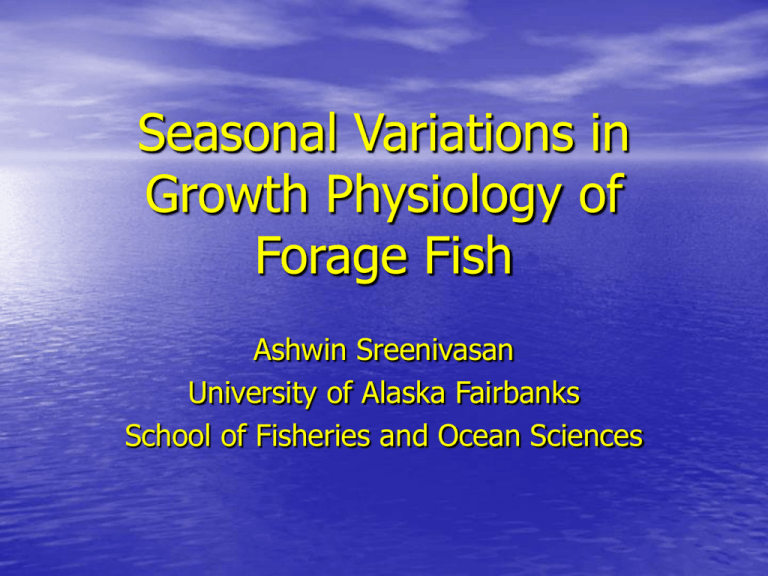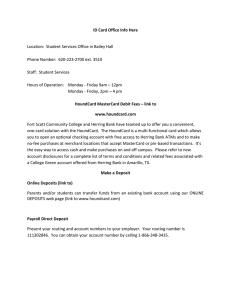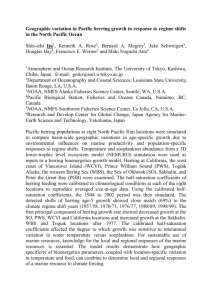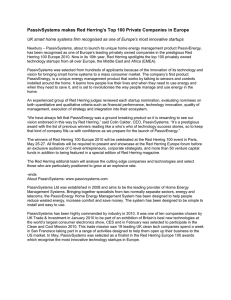Seasonal Variations in Growth Physiology of Forage Fish Ashwin Sreenivasan
advertisement

Seasonal Variations in Growth Physiology of Forage Fish Ashwin Sreenivasan University of Alaska Fairbanks School of Fisheries and Ocean Sciences Juvenile Fish Growth • Affected by environmental variation: – seasonality – habitat – temperature – diet • Direct and indirect effects on growth • Complex interactions Juvenile Fish Growth • Growth – reproduction – condition – ecological growth models • Growth estimation methods – baseline data – seasonal metabolic patterns – population health Physiological Growth Estimation • Physiological growth indices – growth at tissue level • Influence of specific parameters – biotic and abiotic • Growth responses across taxa • Vital inputs in ecological growth models Physiological Indices Criteria • Desired characteristics of a growth index - sensitivity - rapidity of response - utility in meshing field and lab data • Physiological growth indices exhibiting above criteria – cellular metabolic enzyme activity – cellular RNA/DNA ratios Cellular RNA/DNA (R/D) Ratio • DNA-cell number/biomass • RNA-protein synthesis • Nutritional stress -RNA fluctuation • RNA concentration/activity variation – protein synthesis – tissue growth – nutritional condition Current Research Forage Fish • Forage fish-Pacific herring, larval gadids (P.cod, • • pollock) – critical ecological importance in Alaskan waters Cascade effect – key prey – Pacific cod, walleye pollock, salmon Seasonal growth physiology -temperature stress -overwinter stress -starvation stress & recovery Current Research • Collaboration: NOAA Auke • • • • • Bay Laboratories Habitat Division Field and lab component Seasonal biology Growth -temperature -diet Integration of indices Bioenergetic patterns/responses Research Study Samples • Juvenile Pacific herring (Clupea pallasii) growth (2008 1st and 2nd series) – habitat – temperature (6oC, 8.5oC, 12.5oC) – diet (starvation/compensatory growth) • Larval Pacific cod (Gadus macrocephalus) growth (2008 & 2009) – temperature (5oC, 8oC) – diet • Larval Walleye pollock (Theragra chalcogramma) growth (2008 & 2009) – temperature (5oC, 8oC) • Lab component: herring study – Marrowstone Marine Laboratory (USGS) – 0+/1+ herring growth – temperature/diet (6oC, 8.5oC, 12.5oC) – 2 phases: feeding and starvation – 3 temperatures – periodic sampling – March 2008 – comprehensive seasonal growth information (R/D, lipids, proteins) • Lab component: cod study – Hatfield Marine Science Center (NOAA) – 0+ P.cod growth – temperature/diet – 2 concurrent phases – 3 temperatures – 4 diets – periodic sampling – April-May 2008 – preliminary larval growth data – repeat in 2009 • Lab component: pollock • study – Hatfield Marine Science Center (NOAA) – 0+ pollock growth (larvae) – 2 temperatures – periodic sampling – April-May 2008 – preliminary larval growth data repeat in 2009 Objectives 1. Identify and compare temperature and diet 2. 3. 4. influenced growth patterns in forage fish Relate physiological growth patterns to survivability/resilience of forage fish stocks Incorporate R/D patterns into R/Dtemperature-growth models Utilize growth patterns as inputs in formulating management plans Larval P.cod RNA/DNA comparison (2008)-Temperature 10 0.16 8 Degrees Growth Rate (mm/day) 8 7 6 5 5 Degrees 0.14 8 Degrees 0.12 0.1 0.08 0.06 4 0 5 10 15 20 25 30 35 22 40 26 30 34 Days Post Hatch Days Post Hatch 6 5 degrees 5.5 R/D Ratio Length (mm) 5 Degrees 9 8 degrees 5 4.5 4 3.5 0 10 20 Days Post Hatch 30 40 38 5 degrees 0 10 20 30 Days Post Hatch Growth Rate (mm/day) 16 14 12 10 8 6 4 2 0 8 degrees 40 0.25 0.2 0.15 0.1 0.05 5 degrees 50 18 23 28 33 Days Post Hatch 10 8 6 4 2 5 degrees 8 degrees 0 0 10 8 degrees 0 12 R/D ratio Length (mm) Larval Pollock RNA/DNA comparison (2008)-Temperature 20 30 Days Post Hatch 40 50 38 Juvenile Herring RNA/DNA Comparison-Compensatory Growth/Temperature (2008 1st series) Ambient Tanks Herring R/D (8.5oC) 9 8 R/D Ratio 7 6 5 4 3 2 Starved/Refed 1 Fed 0 3/13 4/12 5/12 6/11 Date Sampled Cold Tanks Herring R/D (6oC) Hot Tanks Herring R/D (12.5oC) 10 8 7 8 6 6 5 4 4 3 Starved/Refed 2 0 3/13 7/11 Fed 4/2 4/22 5/12 Date Sampled 6/1 2 1 6/21 0 7/11 3/13 Starved/Refed 3/23 4/2 4/12 4/22 Date Sampled 5/2 5/12 5/22 6/1 Juvenile Herring Lipid ComparisonCompensatory Growth/Temperature (2008 1st series) Ambient Tank Herring Lipid % 12 Lipid % 10 8 6 4 Starved/Refed 2 Fed 0 3/23 4/2 4/12 4/22 5/2 5/12 5/22 6/1 6/11 6/21 7/1 Date sampled Hot Tank Herring Lipid % Cold Tank Herring Lipid % 14 12 12 10 10 8 8 6 6 4 Starved/Refed 2 Fed 0 4/12 4/22 5/2 5/12 5/22 6/1 Date sampled 6/11 6/21 4 2 7/1 0 7/11 3/13 Starved/Refed 3/23 4/2 4/12 4/22 Date sampled 5/2 5/12 5/22 6/1 Applications-Growth Performance • RNA activity-temperature caveat • R/D-growth-temperature calibration models • Growth performance (Gpf=G/Gmax) • Measure of larval condition • Formulation of reference growth rate (Gref) • Estimated Gpf across species Growth Performance • Applications to Pacific herring-specific growth models • R/D-growth-temperature models for starved herring across temperatures • Possible R/D cutoff point • Understanding growth during seasonal (winter) starvation and recovery periods in herring life-history Ongoing Research • RNA/DNA analyses: -juvenile herring (2nd stage replication) -juvenile cod & pollock (2009 samples) • Metabolic enzyme analyses: -juvenile herring (2008 samples) • Incorporation of R/D data into species specific growth models Acknowledgements • Rasmuson Fisheries Research Center Board • School of Fisheries and Ocean Sciences • Dr. Bill Smoker • NOAA Auke Bay Laboratory • Dr. Stanley Rice, Dr. Ron Heintz, and J.J. Vollenweider




